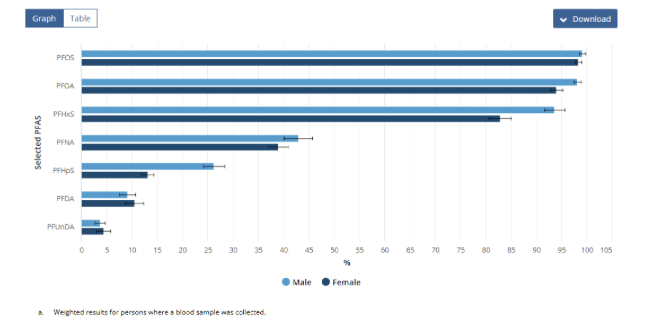New ABS data on PFAS levels after National Health Measures Survey
Simon Mumford
28 May 2025, 12:02 AM

New information on per- and polyfluoroalkyl substances (PFAS) was released yesterday by the Australian Bureau of Statistics (ABS), following its National Health Measures Survey (NHMS) 2022–24, which was a voluntary survey where blood and urine samples were tested for biomarkers of chronic disease, nutrient levels and 11 types of PFAS chemicals.
PFAS are defined as fluorinated substances that contain at least one fully fluorinated methyl or methylene carbon atom.
James Eynstone-Hinkins, ABS head of health statistics, said: ‘This data will help to create a national baseline for levels of PFAS in the Australian population. The dataset will enable future monitoring and support further research into PFAS and the potential impacts of these chemicals on human health,’
11 types of PFAS were tested for people aged 12 years and over in the National Health Measures Survey. Three types of PFAS were detected in the blood of over 85 per cent of the population, while six types were detected in less than 10 per cent of people. The remaining 2 types of PFAS had detection rates between 15% and 45%.
‘PFAS levels varied, but in general, people who were older had higher PFAS levels. This was in line with expectations as there have been changes in the population’s exposure to PFAS over time,’ Mr. Eynstone-Hinkins said.
‘PFAS levels were also generally higher for males than for females.’
Proportion of people aged 12 years and over(a) with a detectable level of selected PFAS by sex, 2022–24

The levels for the three most prevalent PFAS analysed (PFOS. PFHxS, PFOA) are lower in Australia than those reported from previous studies in the United States, Canada and Europe. The timeframe for each of these studies varied, potentially impacting the comparability of recorded PFAS levels.
PFAS have many commercial uses. They are known for their resistance to heat, stains, grease, and water. These properties have made them useful in various applications, including stain and water protection for carpets, fabric, furniture and apparel, paper coating, metal plating, photographic materials, aviation hydraulic fluid, cosmetics and sunscreen, and medical devices.
However, concerns have been raised about the environmental impact and potential health risks of PFAS. These chemicals are highly mobile in water, meaning they can travel long distances from their source. They also persist in the environment and are toxic to various animals.
The Australian Government aims to reduce the presence of PFAS in the environment and protect human health. These include restrictions on the use of PFAS in firefighting foam and other products, as well as a commitment to clean up contaminated sites.
The government has acknowledged that historical use of PFAS in firefighting foams has led to elevated levels of these chemicals at airports, defence bases, and other sites where firefighting training has occurred. They have also been found in areas near industrial areas, effluent outfalls, and landfill sites.
While the full extent of the human health impacts of long-term PFAS exposure remains unclear, the government is taking a precautionary approach, citing global concerns about the persistence and mobility of these chemicals. The government has stated that it has been working to reduce the use of certain PFAS since 2002.
PFAS levels in the Australian population, as announced by the ABS's National Health Measures Survey, now have a base for new surveys to compare.
DENTISTS/DENTURES


